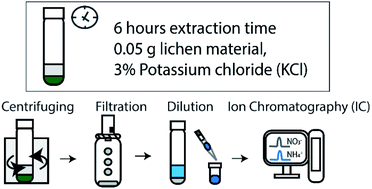Distinguishing atmospheric nitrogen compounds (nitrate and ammonium) in lichen biomonitoring studies†
Abstract
Nitrogen speciation, i.e. distinguishing nitrate (NO3−) and ammonium (NH4+), is commonly undertaken in soil studies, but has not been conducted extensively for lichens. Lichen total nitrogen contents (N wt%) reflect airborne atmospheric nitrogen loadings, originating from anthropogenic sources (e.g. vehicular and agricultural/livestock emissions). Albeit nitrogen being an essential lichen nutrient, nitrogen compound (i.e. NO3− and NH4+) concentrations in the atmosphere can have deleterious effects on lichens. Moreover, N wt% do not provide information on individual nitrogen compounds, i.e. NO3− and NH4+ which are major constituents of atmospheric particulate matter (e.g. PM10 and PM2.5). This study presents a novel method to separate and quantify NO3− and NH4+ extracted from lichen material. An optimal approach was identified by testing different strengths and volumes of potassium chloride (KCl) solutions and variable extraction times, i.e. the use of 3% KCl for 6 hours can achieve a same-day extraction and subsequent ion chromatography (IC) analysis for reproducible lichen nitrate and ammonium concentration determinations. Application of the method was undertaken by comparing urban and rural Xanthoria parietina samples to investigate the relative importance of the two nitrogen compounds in contrasting environments. Findings presented showed that lichen nitrogen compound concentrations varied in rural and urban X. parietina samples, suggesting different atmospheric nitrogen loadings from potentially different sources (e.g. agricultural and traffic) and varied deposition patterns (e.g. urban layout impacts). Despite potential impacts of nitrogen compounds on lichen metabolism, the approach presented here can be used for quantification of two different nitrogen compounds in lichen biomonitoring studies that will provide specific information on spatial and temporal variability of airborne NO3− and NH4+ concentrations that act as precursors of particulate matter, affecting air quality and subsequently human health.



 Please wait while we load your content...
Please wait while we load your content...